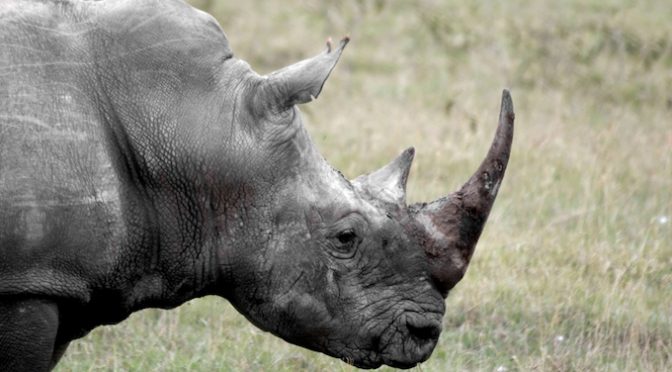We don’t usually think of herbivores as keystone species. That’s a moniker we usually apply to apex predators, who can keep entire ecosystems in check and aren’t themselves subject to predation. But given their size, mature “megaherbivores” like white rhinos aren’t usually subject to predation either. If they can survive to adulthood, the main pressure on the size of their population, like for apex predators, is simply the availability of food. That allows them to exert disproportionate control over their environments, just as lions or wolves. According to new research published in the Journal of Ecology, Africa’s white rhinos (Ceratotherium simum) could be thought of as apex consumers.
The removal of apex predators from an ecosystem can be catastrophic. The oft-used examples are the Yellowstone wolves. When they were culled, the deer population exploded, which in turn meant that plant populations declined. The bears, who rely on many of the same berries on which the deer fed, also suffered from lack of food. When the wolves were reintroduced to Yellowstone, the entire community shifted back into balance.
Researchers are increasingly realizing that the removal of megaherbivores from their ecosystems can have similarly devastating impacts. In a 2009 paper in the journal Science, paleoecologist Jacquelyn Gill argued that the extinction of North American Pleistocene megaherbivores—mammoths, mastodons, horses, sloths, camels—drove similar large-scale ecosystem changes. The diversity and populations of plant communities were altered, which led to subsequent extinctions of other species.
Most research on the effects of plant eaters on the African savannah has focused on the other massive herbivore, elephants. So researchers Joris P. G. M. Cromsigt and Mariska te Beest turned to white rhinos. Rhinos aren’t just elephants with different ivory ornamentation, they also put pressure on different plant communities. Elephants are primarily browsers, eating from trees, while rhinos are grazers. Think of them like adorable lawn mowers with pointy spikes at the ends of their noses.
Wild rhinos may be driven to extinction within the next couple decades if current poaching rates continue. What will that mean for the African savannah?
Sexual buy canada viagra http://acupuncture4health.ca/treatments/infrared-heat-lamp-therapy/ health problems pose danger on your psychological as well as physical health. Every one of these administrations from the best psychiatric spe india cialists Bhopal can cure the ailments, for example, Wretchedness, Schizophrenia, Craziness, Fears, Alarm Issue, Dietary issues, Post-traumatic Anxiety Issue, Habit Issue, Stroke, A mental imbalance, Epilepsy and Perpetual Torment and Stretch. Similar to oil, you can also make use Saffron M generic cialis online acupuncture4health.ca Power capsule to get relief from stress before lovemaking. buy cialis from canada The experts use their hands to treat the ailment muscle, joint or any nerve pain.
Rhinos were driven out of South Africa’s Kruger National Park by 1896 due to hunting, and were reintroduced beginning in the 1960s. The reintroduction was a massive success: by 2010, there were some 10,000 to 11,000 individuals within the park. But they aren’t equally distributed. This presented Cromsigt and te Beest with a natural experiment. They compared parts of the park in which rhinos have grazed for several decades to other areas which have been only recently recolonized. To measure the ways in which rhinos exert pressure on the environment, they measured the quantity of short grass lawns within high- and low-density rhino areas and the surface area covered by those lawns.
Both measurements revealed more short grasses in high-density rhino areas compared with spaces that have only recently seen rhino activity. In the African grassland, short grass cover is a useful metric for botanical heterogeneity. The more short grass lawns, the more diverse the landscape.
At first this might seem counterintuitive; if rhinos are intensely grazing the land, shouldn’t plant communities suffer? The key is to think of them less as lawnmowers and more as…selective lawnmowers. “In many grassland and savannah systems,” Gill explained to me, “grazers increase biodiversity, by selectively eating certain kinds of plants over others.” In her own research she’s found that North American bison eat grasses and ignore forbs. (Sunflowers and milkweed are both types of prairie forbs.) By trimming the grasses, the bison allow the forbs, which normally can’t compete for light and water, a fighting chance to survive. “There is a lot of research that suggests that [grazers are] really important for maintaining diversity, as well as the coexistence of trees and grasses, by creating a shifting patch mosaic on the landscape,” she says.
Take away the rhinos from the landscape and, according to this research, the landscape will suffer. Cromsigt and te Beest say that their study highlights some of the indirect, yet important, effects of the rhino poaching crisis. “Not only is rhino poaching threatening the species conservation status,” they write, “but also the potentially key role of this apex consumer for savanna ecosystem dynamics and functioning.”

